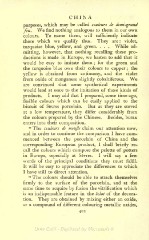Page 492 - Oriental Series Japan and China, Brinkly
P. 492
CHINA
purposes, which may be called couleurs de demi-grand
Wefeu. find nothing analogous to them in our own
colours. To name them, will sufficiently indicate
those which we qualify thus. They are : violet,
turquoise blue, yellow, and green. . . . While ad-
mitting, however, that nothing recalling these pro-
ductions is made in Europe, we hasten to add that it
would be easy to imitate them for the green and
;
the turquoise blue owe their colours to copper ; the
yellow is obtained from antimony, and the violet
Wefrom oxide of manganese slightly cobaltiferous.
are convinced that some synthetical experiments
would lead at once to the imitation of these kinds of
products. I may add that I prepared, some time ago,
fusible colours which can be easily applied to the
biscuit of Sevres porcelain. But as they are stoved
at a low temperature, they differ considerably from
the colours prepared by the Chinese. Besides, borax
enters into their composition.
" The couleurs de moufle claim our attention now,
and in order to continue the comparison I have com-
menced between the porcelain of China and the
corresponding European product, I shall briefly re-
call the colours which compose the palette of potters
in Europe, especially at Sevres. I will say a few
words of the principal conditions they must fulfil.
It will be easy to appreciate the differences to which
I have still to direct attention.
" The colours should be able to attach themselves
firmly to the surface of the porcelain, and at the
same time to acquire by fusion the vitrification which
is an indispensable feature in the eclat of the decora-
tion. They are obtained by mixing either an oxide,
or a compound of different colouring metallic oxides,
402

